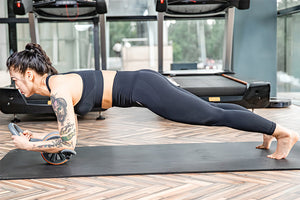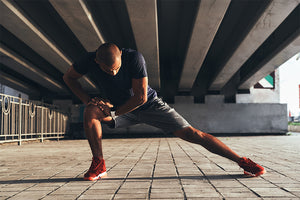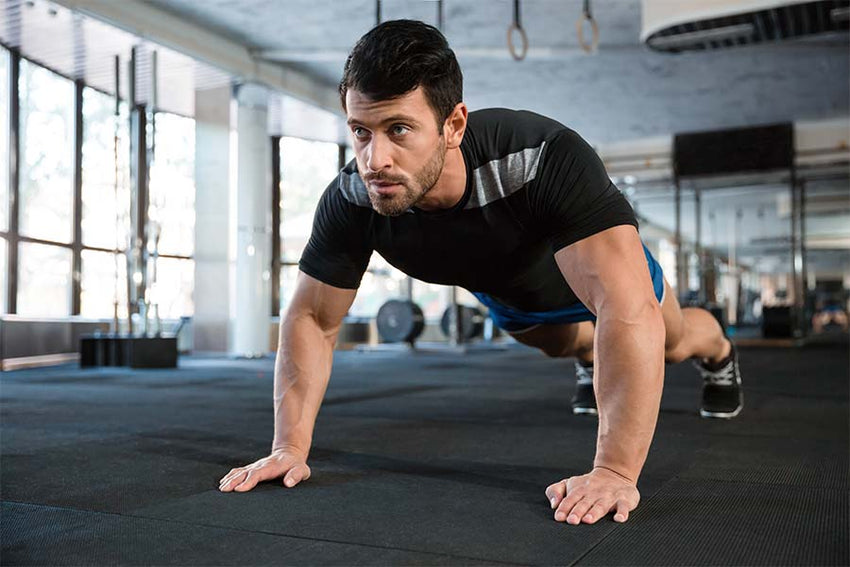Have you ever been in a situation where you are in the middle of your training regimen, and you start feeling burned out? The same old routine is beginning to feel like a drag, and your motivation is flagging. You're not alone - even the most dedicated fitness buffs can find themselves in a workout slump from time to time.
But don't despair! One of the best ways to rekindle your passion for fitness is to mix things up with some cross-training.
So, the next question that comes up is, what is cross-training? Cross-training involves mixing up your workout routine with different types of activities. For example, if you normally go for a run, you might try biking or swimming instead. Or, if you typically lift weights, you could try some cardio exercises.
By incorporating new activities into your routine, you can target different muscle groups, avoid overuse injuries, and see progress in areas that you might have hit a plateau with before.
And the best part is that cross-training doesn't have to be expensive or time-consuming- simply adding a few new exercises to your current routine can make all the difference.
By mixing things up, you can avoid boredom and keep your body guessing. As a result, you'll be more likely to stick with your workout plan and see results.
While cross-training may seem like a recent trend, it actually has a long history. In the early 1900s, Finnish Olympian Paavo Nurmi was known for his "secret weapon" of cross-training, which he used to dominate middle-distance running events.
Today, cross-training remains popular among athletes of all levels, from weekend warriors to professional athletes. Unlike single-sport training programs, cross-training provides a well-rounded approach to fitness that can help improve endurance, strength, and speed.
So, if you're looking for a way to spice up your workout routine, cross-training may be the answer.
Benefits of Cross-Training
As any athlete knows, cross-training is essential for maintaining peak performance. By working on various muscle groups and using different movement patterns, cross-training helps to create a well-rounded, balanced physique. But there are various other benefits of practicing cross-training; some of the major ones include:
Boosts Cardiovascular Endurance
Athletes are well aware that cross-training is essential for boosting cardiovascular performance. By working on certain muscle groups, cross-training helps to condition the heart and lungs, resulting in improved endurance and greater cardiovascular efficiency.
By alternating between different exercises, cross-training activities help keep the heart rate up and improve blood circulation. In addition, it assists in increasing lung capacity and improving respiratory function. As a result, a cross-training workout plan is an essential part of any athlete's cardiovascular training regimen.
New research suggests that swimming may actually be better for your cardiovascular health. In a recent study, a group of elite runners and swimmers were compared in terms of left ventricle function.
The left ventricle is a major part of the heart responsible for pumping oxygenated blood throughout the body. The study found that while runners' left ventricles functioned slightly differently than swimmers', the swimmers demonstrated higher cardiac output.
In other words, they pumped more blood at a faster rate. So, if you're looking to give your heart a workout, cross-training offers the best cardiovascular exercise program.
Trains Unused Muscle Groups
Cross-training can help you target muscles that are not usually targeted in main sports. Swimming can be a better choice if you wish to target your back muscles, but weight training can be good for targeting leg muscles.
Cross-training helps because it uses different motions and levels of resistance to work for the same muscle group from different angles. This allows you to not only break up the monotony of your workout routine but also to focus on weaker areas that might be neglected during your regular routine.
Cross-training is, therefore, an essential part of any fitness regime. By incorporating different forms of exercise into your routine, you can ensure that all of your muscle groups are being worked on, leading to a more balanced and healthy body.
In fact, researchers recently examined the relationship between opposing muscle groups and found that greater mobility in antagonistic muscles lead to greater power for agonist's muscles.
In other words, cross-training your muscles can help you unlock previously untapped potential in your prime movers. The study participants who engaged in a cross-training regimen saw significant improvements in their performance on tests of muscular power compared to those who did not cross-train.
Quicker Recovery From Main Sport
Cross-training workouts are beneficial for athletes because they help improve recovery from the main sports event. Cross-training helps by providing a different stimulus to the body that can aid in the recovery process.
For example, if an athlete normally runs long distances, cross-training with swimming can provide a low-impact workout that will still help to keep the muscles active without putting repetitive strain on the body.
Additionally, cross-training can help to flush out lactic acid and other toxins that can build up in the muscles after strenuous exercise. This is because cross-training workouts typically involve a different range of motion than the main sport, which helps to stretch out the muscles and promote blood flow.
As a result, cross-training is an integral part of any athlete's regime and can be especially helpful in promoting easy recovery from the main sports event.
Related Article: Active Recovery Vs. Passive Recovery: Which is the Best Choice for You?
Enhances Mental Engagement
Cross-training workouts help keep you mentally engaged by providing a change of scenery and new challenges. When you stick to the same workout routine, it's easy to get bored and even discouraged.
But when you mix things up with cross-training, you're constantly kept on your toes. Not only do you have to learn new movements and exercises, but you also have to adapt to different surroundings and equipment. This variety helps to keep your mind sharp and your motivation high.
Overall, you will be able to prevent mental burnout and keep yourself motivated to stay in shape. So, if you're looking for a workout that will keep you both physically and mentally engaged, cross-training is a great option.
Minimizes the Risk of Injury
There's no denying that cross-training is a great way to reduce the risk of injury. By working different muscle groups and using different equipment, you can avoid overuse injuries and keep your body healthy. But how exactly does cross-training reduce the risk of injury?
For one thing, cross-training helps to improve your overall fitness level. When you're in better shape, your body can handle the demands of your workouts better. You're also more likely to prevent injury when you have a strong base of fitness to work from.
In addition, cross-training helps to increase your range of motion. If you constantly use the same muscle groups, you will lead yourself to overuse injuries.
Working on different muscle groups can improve your flexibility and reduce the likelihood of developing muscle imbalances. This can help you stay healthy and avoid injuries, both in the short and long term.
So, if you're looking for a reduced risk of injury, cross-training is a great option. By improving your fitness level and increasing your range of motion, you can keep your body healthy and avoid any potential problems down the road.
Picking the Right Cross-Training Workout

When it comes to cross-training, there are a lot of options out there. But how do you know which one is right for you and your goals? Here are a few things to keep in mind when choosing a cross-training workout:
First, consider what type of exercises you typically do. For example, if you're a runner, you might want to focus on cross-training workouts that improve your upper body strength or flexibility. Conversely, if you're mostly a weightlifter, you might want to focus on exercises that improve your cardiovascular fitness.
Second, think about what type of results you're hoping to achieve. Are you looking to build muscle? Improve your endurance? Or just mix things up and try something new? Whatever your goals, make sure your cross-training workout is helping you move closer to them.
Finally, don't be afraid to experiment! There are so many different cross-training workouts out there, and the only way to find out which one is right for you is to try it yourself. So, go ahead and give a few different options a shot - eventually, you'll find the perfect fit.
Let's have a quick look at different kinds of goals and the right cross-training workout fit as per that:
Goal: Strength
For many people, the goal of working out is to get stronger. And while there are many different ways to achieve this goal, cross-training is one of the most effective. This approach has several benefits when it comes to muscle strength.
First, it helps to prevent boredom and keeps you motivated. Second, it allows you to work different muscle groups, which can lead to better overall muscle development. Third, it can help improve your balance and coordination. And fourth, it can reduce your risk of injury by decreasing the amount of stress on any one muscle group.
Workout type: Metabolic Training
When it comes to cross-training for increasing muscle strength, few methods are as effective as metabolic training. Also known as HIIT or high-intensity interval training, metabolic training is a type of exercise that alternates between short bursts of high-intensity activity and brief periods of rest.
This type of training is highly effective at boosting muscle strength because it helps to increase the production of ATP, the energy molecule that muscles use to contract. In addition, metabolic training also helps to improve muscle endurance and cardiovascular fitness.
As a result, it is an excellent way to cross-train for those who are looking to increase their muscle strength. Some example exercises include TRX rows, sled push, bear crawls, etc.
Related Article: Strength Training: The Perfect 3 Days Workout Plan for Footballers
Goal: More Speed
For any runner, the goal is always to increase speed. But sometimes, training can feel like a never-ending uphill battle. That's where cross-training comes in. By incorporating other forms of exercise, runners can build muscle strength and endurance, both of which are essential for increasing speed.
By working on different muscle groups, you can help improve your overall muscle support and efficiency. This will make it easier for your body to handle the impact of running and help you move more quickly. So, if you're looking to pick up the pace, cross-train your muscles!
Workout type: Targeted Strength
If you're looking to increase your running speed, targeted strength exercises can be a big help. Leg exercises, in particular, can help to build muscle strength, which can then translate into more speed on the running track.
For example, squats and lunges are great exercises for building power in the legs. And if you really want to up your game, you can try doing weighted or plyometric squats and lunges. Bentover rows, single-arm TRX rows, or cable pail-off presses can be excellent for better coordination and core strength.
Goal: Hypertrophy
Most people cross-train with the goal of muscle hypertrophy or increasing muscle size. To achieve this, you need to focus on exercises that help build muscle strength.
This can be done through lifting weights, using resistance bands, or even bodyweight exercises like push-ups and pull-ups. The key is challenging your muscles and pushing yourself outside your comfort zone. This will help to break down muscle tissue and stimulate new muscle growth.
Workout Type: Functional Circuit Training
If you're looking for an excellent way to cross-train and achieve the goal of hypertrophy, functional circuit training is the way to go. This type of training is designed to help your body adapt to new challenges and stresses, which is essential for building muscle.
By working for different muscle groups in a circuit, you're able to keep your body guessing, ensuring that you're always making gains. So, circuit training is the best solution.
Related Article: 20 Minutes Post-Workout Fat-Blasting Circuit Routine
Goal: Faster, Sustained Cycling
The goal of every cyclist is to ride faster, longer, and with greater ease. And while cycling provides an excellent workout, it can also lead to tight muscles and imbalances in the body. That's where cross-training comes in.
By cross-training, you'll be able to ride with greater power and endurance, and you'll be less likely to experience pain or stiffness during or after a ride. So if you're looking to take your cycling to the next level, cross-training with yoga is a great place to start.
Workout Type: Stretches
Although cycling is often thought of as a relatively low-impact activity, the fact is that it can place a great deal of strain on the muscles and joints. As a result, many cyclists find that they need to supplement their training with stretching exercises in order to avoid injuries.
Not only does this help to maintain flexibility, but it can also improve the range of motion and prevent cramping during long rides. In addition, stretches in cross-training can help to improve cycling performance by increasing power and endurance.
Weekly yoga sessions and/or using a foam roller before and after rides can be beneficial. DMoose offers a high-quality foam roller to help you target your glutes, quads, middle back, etc.
Goal: Athletic Perfection
Cross-training to become an elite athlete requires dedication, commitment, and a lot of grit. But it's also incredibly rewarding, both physically and mentally.
Cross-training helps improve athletic performance by building strength, endurance, and flexibility. Whether you aim to be an MMA fighter, boxer, or basketball player, cross-training is the practice that will make you perfect.
Workout Type: Power Training
Many athletes know that power training is a type of cross-training that can help them achieve the goal of athletic prowess. This type of training helps you to develop explosive power, which is essential for activities such as sprinting and jumping.
In addition, power training can also help you improve your speed and agility. Workouts like banded sprints, box jumps, suicide sprints, etc., can work exceptionally in improving your athletic prowess.
FAQs
1. What does cross training do for your body?
Cross training can help to improve your overall fitness level. By working different muscle groups and using different energy systems, you'll become more well-rounded and better equipped to handle any physical challenge that comes your way.
2. What is better, cross-training or elliptical?
Cross-training is great for getting a full-body workout. It provides resistance that challenges your arms, legs, and core, making them ideal for building strength and improving cardiovascular endurance. Ellipticals, on the other hand, are low-impact machines that are easy on the joints. So, which is better? Ultimately, it depends on your goals and preferences.
3. Is cross-training good for runners?
Yes. It can help runners build strength, improve their range of motion, and reduce the risk of injury. It can also help to improve their running form and increase their speed.
4. What is low impact cross-training?
Low impact cross-training is a type of exercise that minimizes the risk of injury to your joints and muscles. It is ideal for people who are new to exercise, or those who have existing health conditions that make high-impact activities like running or jumping unsafe.
TRENDING ARTICLES
Bottom Line
Cross-training is an excellent way to improve your overall fitness, whether you're looking to build muscle, become more flexible, or even just ride your bike faster. By incorporating a variety of exercises into your routine, you'll be able to challenge your body in new ways and achieve your fitness goals. So, what are you waiting for? Get out there and start cross-training!




























